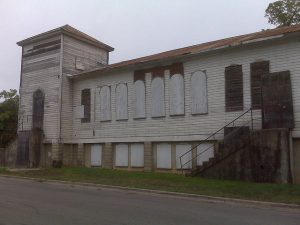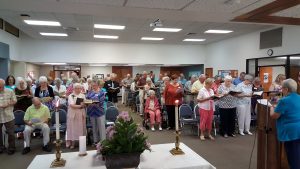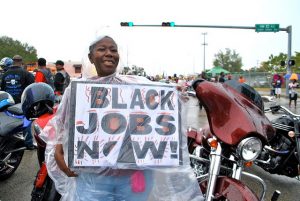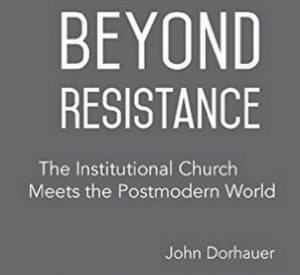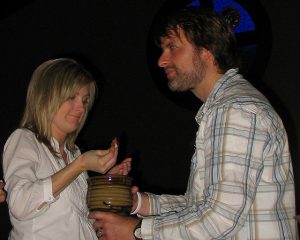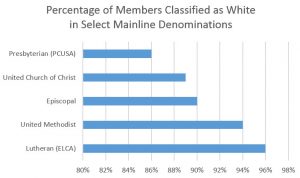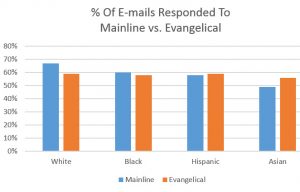Sermon Text: Acts 16:25-34 Sermon Excerpt Are you saved? Maybe that is a question you have not heard in a long time. Maybe it is one you have heard far too often. Are you saved? Earlier this week when a group gathered for a Topical Tuesday conversation about salvation we had more stories to tell than time allowed. One participant remembered a time when as a young mother she had allowed a stranger into her home simply because she craved interaction and conversation with Read More …
The Obsolete Church (#1580)
Rev. Osagyefo Uhuru Sekou is an author, documentary filmmaker, public intellectual, organizer, pastor, and theologian. In a recent interview, his response to Sarah Van Gelder's question about the role he sees for the churches now included these challenging words: We have a romantic view of the church . . . I think a church has a role to play, but this idea of the Church, with a big C, I think is obsolete. So What? I encounter extreme views of the Church (capital C church of Read More …
Embracing New Perspectives (#1579)
My wife and I have been homeowners as long as we have been a couple with a small gap between the sale of one home and purchase of another years ago. Normal for us has been owning one home, except for temporarily owning two while in the process of relocating. When the housing bubble burst and our primary residence was so far underwater we could no longer see the surface, we chose to buy then to buy again in hopes that when the market started to rise again we could Read More …
Marginalization as Blessing (#1578)
I cannot even begin to count the number of experts I have heard or read complain about the losses experienced by liberal/progressive (Mainline, Oldline, Sideline) Christianity over the last several decades. I am thankful those voices are beginning to fade as new voices emerge suggesting what this new role means and how God can and is working in and through it. Amy Butler, senior minister of Riverside Church, recently stated that the continued trend toward Read More …
Sermon: Spiritual Glue (#1577)
Sermon Text: Hebrews 8:6-13 Sermon Excerpt We are a part of the United Church of Christ, a tradition that boldly proclaims “our faith is 2,000 years old but our thinking is not.”This tradition – our denomination – is a network of around 5,000 congregations and nearly 1 million members. We also claim to be a multiracial and multicultural church, and a church that emphasizes covenant. Let me slow down here . . . Before I can even comment on whether or not we have achieved or at least Read More …
Prayers for Racial Justice (#1576)
This Sunday, August 9, 2015, is the first anniversary of Mike Brown's death. On this day the congregation I pastor (Fort Myers Congregational United Church of Christ) will join with hundreds and perhaps thousands of other congregations in the United Church of Christ by including prayers for racial justice as a part of services of worship. This shared emphasis is the direct result of a group of faith leaders who have met regularly by conference call under the leadership of Read More …
August Book Recommendations (#1575)
During the month of July I went through what had become a rather large pile of physical books and list of electronic books I had intended to read by mid-year. I managed to read 16 such books and gave away around an equal number. The top ten I read that were published last year or this year follow. (5+) Beyond Resistance: The Institutional Church Meets the Postmodern World by John Dorhauer (Exlporation Press, 2015) (5) Move Your Bus: An Extraordinary New Approach to Read More …
Sermon: A Monthly Meal (#1574)
Sermon Texts: Ephesians 4:1-6 (NRSV) and John 6:24-35 (The Message) Sermon Excerpt Some people like to watch birds. Other people like to watch the water. Still others like to watch television or computer screens. I like to watch people. It is a habit I carry with me wherever I go, including here in our sacred space. I should, perhaps, begin with a word of thanks to the person or people who chose to place the pastor’s chair in two different but equally Read More …
Mainline: Lacking Racial Diversity (#1573)
Race related topics have been featured in the news more in recent months than any time I can recall. Mainline Protestants generally tend to have healthy perspectives on race. Such philosophical and even theological understandings do not necessarily translate into action (for example: read my summary and reflection of Bradley Wright's recent research showing that Mainline Protestant congregations had the highest rate of discrimination to prospective visitors) nor do they Read More …
Racism: A Mainline Reality (#1572)
Meet the Researcher Bradley (Brad) Wright is an associate professor of sociology at the University of Connecticut where he studies American Christianity and spirituality. He is the author of two books: Christians are Hate-Filled Hypocrites… and Other Lies You’ve Been Told (2010 - my review), and Upside: Surprising Good News about the State of Our World (2011 - my review). Research Overview Wright and another researcher researched how Christian churches Read More …

